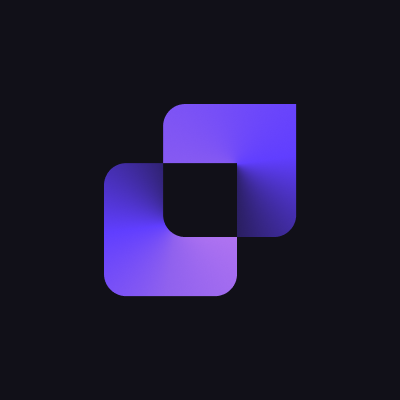
Leadpages is a user-friendly landing page builder with a drag-and-drop editor and high-converting templates. It offers powerful A/B testing, mobile optimization, and seamless integrations. Ideal for businesses seeking easy lead generation and conversions.
- Easy drag-and-drop editor
- Wide range of high-converting templates
- Built-in A/B testing
- Mobile-friendly design
- Strong integrations with third-party tools
- Excellent customer support
- Limited customization options
- Higher pricing compared to alternatives
- Basic built-in analytics
Hey there! Welcome to my detailed Leadpages Review 2025. I’m a digital marketer running a small agency, and I’ve been using Leadpages on and off since 2018- seven years of building landing pages for myself and clients.
Back then, Leadpages was my first landing page builder, and I loved its simplicity. However, as my needs grew, I explored other tools like Unbounce and ClickFunnels, only to return to Leadpages in 2024 after hearing it had improved a lot.
In this Leadpages review, I’ll share my genuine experience, explain why Leadpages remains a fantastic and affordable choice for solopreneurs and small businesses, and break down its features, pricing, pros, cons, and alternatives in detail.
Table of Contents
ToggleA Glimpse of Leadpages Review
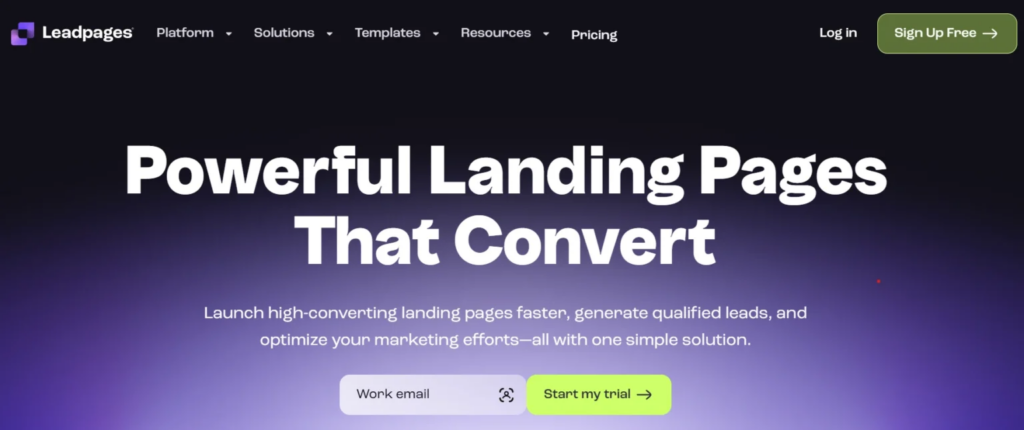
Leadpages is a user-friendly platform designed to help businesses and individuals create high-converting landing pages, pop-ups, alert bars, and websites without needing advanced technical skills.
It offers a drag-and-drop builder, customizable templates, and features like A/B testing, email and SMS campaign tools, and integrations with popular marketing tools (e.g., Mailchimp, Stripe).
Leadpages aims to drive lead generation and sales by optimizing conversions, with plans starting at $37/month (billed annually) for a single site, unlimited leads, and core features.
Higher-tier plans unlock advanced tools like online payments and multi-site support.
My Personal Journey with Leadpages
As a small business owner seeking to establish a strong online presence, I came across Leadpages while searching for a tool to create professional-looking landing pages without requiring extensive coding skills.
Intrigued by its promise of user-friendly design and powerful conversion tools, I decided to give it a try. Here’s my personal journey with Leadpages, reflecting on how it transformed my approach to digital marketing.
Getting Started: A Seamless Onboarding Experience
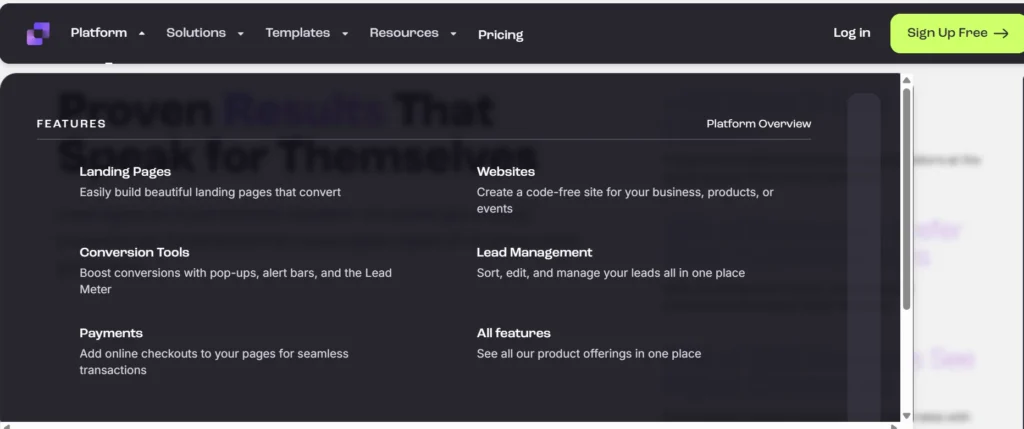
When I first visited the Leadpages website, I was impressed by the clean interface and the clear emphasis on helping businesses convert clicks into customers.
I signed up for the 14-day free trial, which gave me access to their drag-and-drop builder, templates, and core features.
As someone with minimal web design experience, I found the platform intuitive. Within hours, I had created my first landing page for a product launch, complete with a sign-up form and a professional look that matched my brand.
The onboarding process was straightforward. Leadpages offered guided tutorials and a library of templates optimized for conversions, which saved me hours of trial and error.
I chose a template tailored for lead generation, customized it with my brand colors, and integrated it with my email marketing tool, all without writing a single line of code.
Building My First Campaign
One of the standout features for me was the ability to create pop-ups and alert bars. I used these to promote a limited-time offer on my website, and the results were impressive.
Within a week, I saw a 20% increase in email sign-ups compared to my previous efforts with a generic website form. The analytics dashboard provided clear insights into visitor behavior, helping me understand what worked and what didn’t.
I started with the Standard plan, priced at $37/month (billed annually), which was perfect for my single-site needs. It included unlimited leads, traffic, and conversions, plus integrations with tools like Mailchimp, which I already used.
The ability to connect my domain seamlessly ensured my landing pages felt like a natural extension of my website.
Scaling Up: Exploring Advanced Features

As my business grew, I upgraded to the Pro plan ($74/month, billed annually) to unlock features like A/B testing and online sales capabilities.
A/B testing was a game-changer. I could experiment with different headlines and call-to-action buttons to determine which ones resonated with my audience. For instance, tweaking a button from “Sign Up Now” to “Get Started Free” increased conversions by 15%.
The Pro plan also allowed me to manage three sites, which was ideal as I began creating landing pages for multiple campaigns.
The opt-in text campaigns were another unexpected win. I set up a simple SMS campaign to drive sign-ups for a webinar, and the response rate was higher than my email campaigns.
The ability to sell products directly through Leadpages also streamlined my sales funnel, reducing the need for third-party e-commerce platforms.
Challenges and Support
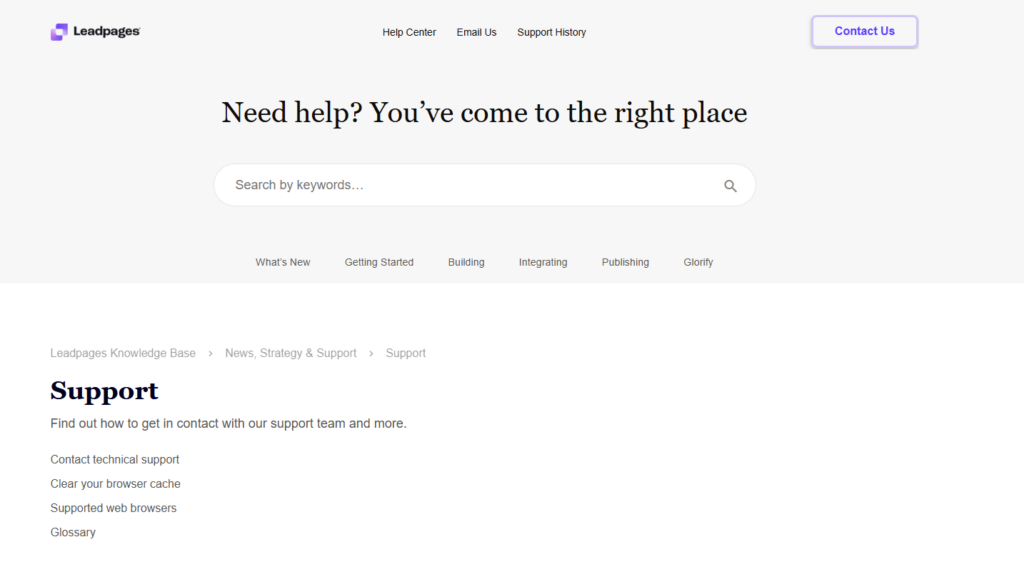
No tool is perfect, and I did face a learning curve with some advanced features, like setting up complex integrations. However, Leadpages’ support team was responsive.
On the Pro plan, I had access to live chat support, which helped me troubleshoot a payment gateway issue in real-time. For more complex needs, I considered the Advanced plan but decided to stick with Pro, as it met my current requirements without requiring me to contact sales for custom pricing.
| My Needs in 2020 | How Leadpages Helped | Why It’s Still Great in 2025 |
| Easy tool for non-coders | Drag-and-drop builder made pages in hours. | Smoother editor, AI tools speed up design. |
| Affordable for startups | $37/month was cheaper than rivals. | Still $37/month, saves $50-$100 vs. Unbounce. |
| High-converting pages | Templates got 20-30% conversion rates. | 200+ templates, Leadmeter boosts conversions. |
| Quick setup for clients | Built pages in 1-2 hours with templates. | Pre-built sections cut setup time by 50%. |
| Scalable for growing agency | Handled 5-10 client campaigns easily. | Unlimited leads/traffic, scales with my 20 clients. |
Leadpages Pricing: Affordable but with Limits🤑

| Plan | Monthly Billing | Annual Billing (Per Month) | Annual Billing (Total) | Key Features Included |
|---|---|---|---|---|
| Standard | $49/month | $37/month | $444/year | 1 site, landing pages, pop-ups, alert bars, unlimited leads, traffic & conversions, 40+ integrations, tech support (email only), domain support |
| Pro | $99/month | $74/month | $888/year | 3 sites, all Standard features, online sales & payments, A/B testing, email trigger links, 10 opt-in text campaigns, tech support (email + chat) |
| Custom | Contact for pricing | Contact for pricing | Contact for pricing | Up to 50 sites, all Pro features, advanced integrations, priority support (phone + priority email/chat), dedicated onboarding, account reviews |
Notes:
- Annual billing offers a discount compared to monthly billing (e.g., Standard saves ~24%, Pro saves ~25%).
- The Advanced plan requires contacting Leadpages for custom pricing.
- All plans include a 14-day free trial.
Features in This Leadpages Review Updated for 2025
Leadpages is a dedicated landing page builder founded in 2012, designed to help small businesses and solopreneurs create high-converting pages without tech skills.
Over seven years, I’ve used its core features to grow my clients’ leads and sales. Below, I’ll explain each feature, how I use it, and why it’s valuable in 2025, with bullets and tables for clarity.
1. Drag-and-Drop Page Builder

The heart of Leadpages is its drag-and-drop editor, which enables you to build landing pages without requiring any coding. In 2025, it’s faster and more intuitive than when I started, with real-time previews and autosave to prevent lost work.
How I Use It:
- Create landing pages for client campaigns, like a fitness coach’s free workout guide sign-up.
- Example: Built a page in 30 minutes using a template, complete with images, text, and a form, resulting in a 25% conversion rate for visitors.
- Adjust layouts (rows and columns) and add widgets, such as buttons or countdown timers.
- Toggle between mobile/desktop views to ensure pages display well on all devices.
Why It’s Great:
- No coding needed, perfect for beginners like me in 2018.
- Autosave and fast loading prevent crashes, unlike my early glitchy experience.
- Pre-built sections (e.g., testimonials, CTAs) save 1-2 hours per page.
- Example: A client’s webinar page received 300 sign-ups in a week after 45 minutes.
2. 200+ Conversion-Optimized Templates
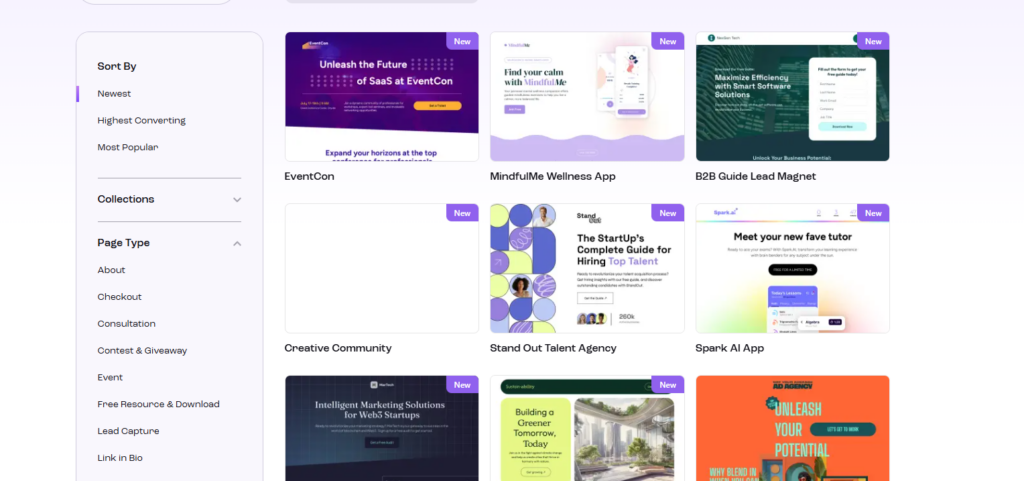
Leadpages offers over 200 mobile-responsive templates for landing pages, popups, and websites, sorted by industry (e.g., health, real estate) or goal (e.g., lead capture, sales). In 2025, templates will be modern and will track average conversion rates.
How I Use It:
- Select a template for quick setups, such as a real estate agent’s open house sign-up.
- Example: Used a “Lead Capture” template, customized it in 20 minutes, and got 40 leads in 3 days.
- Filter by conversion rate to choose high-performing designs.
- Save my templates for reuse, cutting client setup time by 30%.
Why It’s Great:
- Templates convert 20-40% out of the box, better than my old WordPress pages (10-15%).
- Mobile-responsive designs save time on manual adjustments.
- New AI-generated templates in 2025 match current trends.
- Example: A client’s eBook download page achieved a 35% conversion rate with a specific template.
| Template Type | How I Use It | Why It’s Great |
| Lead Capture | Build sign-up pages for eBooks or webinars. | High conversions (20-40%), easy to edit. |
| Sales Pages | Create product offer pages for coaching clients. | Checkout widgets boost sales, mobile-friendly. |
| Event Sign-Ups | Promote client workshops or open houses. | Filters by goal save time, modern designs. |
| Custom Templates | Save my designs for repeat clients. | Reusable, cuts setup time by 30-50%. |
3. Lead Generation Tools
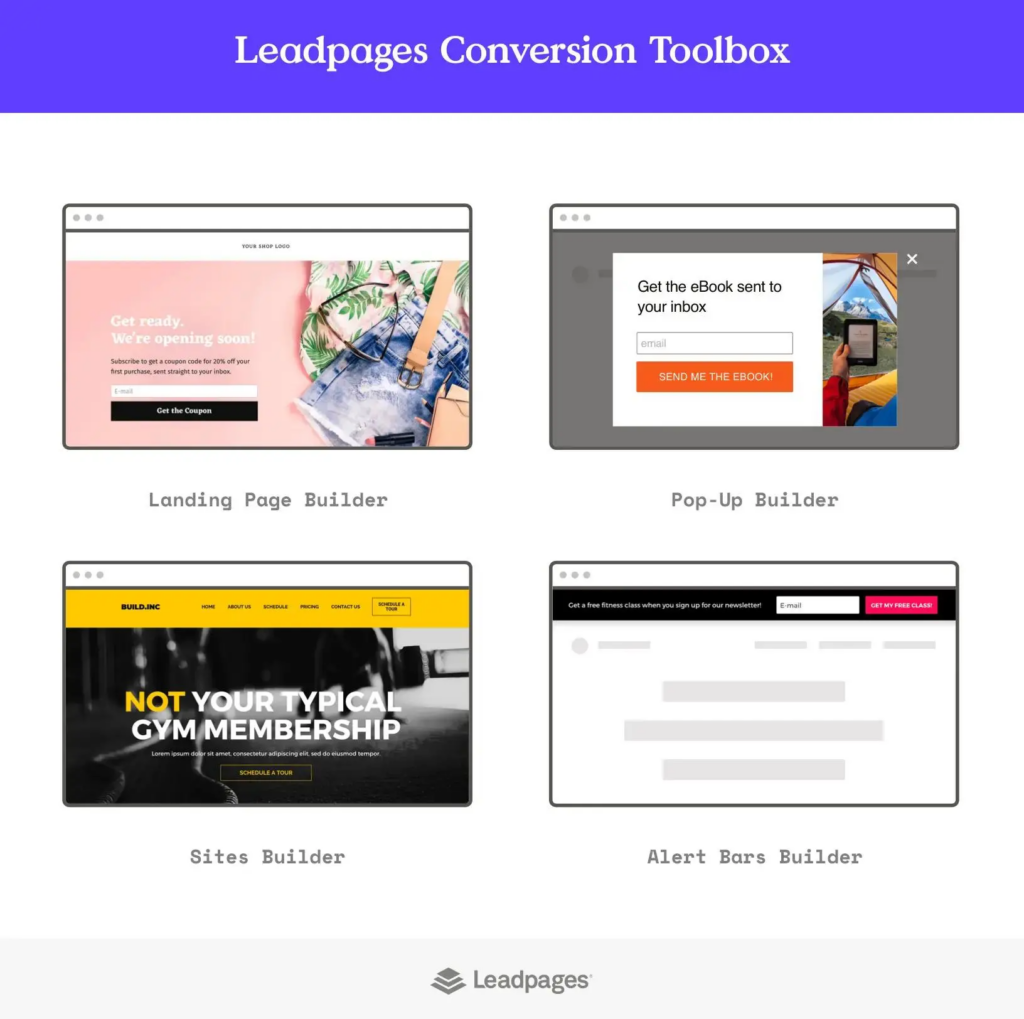
Leadpages shines at capturing leads with pop-ups, alert bars, and forms. Its Leadmeter tool gives real-time tips to improve conversions, and lead magnet delivery sends files instantly.
How I Use It:
- Add pop-ups to client sites for email sign-ups, like a “10% off” offer for a store.
- Example: A pop-up on a fitness site grew the email list by 200 subscribers in a month.
- Use Leadmeter to tweak headlines and CTAs, boosting conversions by 10-15%.
- Deliver lead magnets (e.g., PDFs) automatically after users submit the form.
Why It’s Great:
- Popups and alert bars are easy to set up, and no coding is needed.
- Leadmeter’s suggestions (e.g., “move form higher”) improve results fast.
- Instant delivery keeps subscribers happy, reducing drop-offs.
- Example: A client’s lead magnet page got 30% more downloads with Leadmeter tweaks.
4. A/B Testing and Analytics
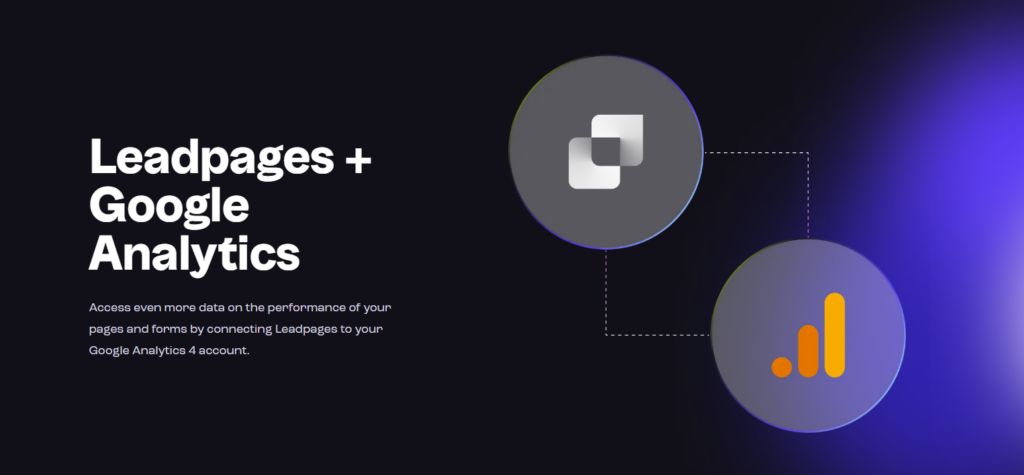
Leadpages offers A/B testing (available on the Pro plan and above) to compare page versions and built-in analytics to track views and conversions. In 2025, analytics are more detailed, showing 90-day trends.
How I Use It:
- Test different headlines or button colors for client pages.
- Example: Changed a CTA from “Sign Up” to “Get Started” and boosted conversions by 12%.
- Track unique views and conversion rates to report results to clients.
- Use analytics to identify drop-off points, such as a form that’s too long.
Why It’s Great:
- A/B testing is simple to set up and takes 5 minutes per test.
- Analytics provide clear data; there is no need for additional tools like Google Analytics.
- Helps justify my fees to clients with hard numbers.
- Example: A/B testing doubled a client’s webinar sign-ups in two weeks.
5. Integrations

Leadpages connects to over 40 tools, including email platforms (Mailchimp, AWeber), CRMs (HubSpot), and payment processors (Stripe). Zapier adds 1,000+ more integrations.
How I Use It:
- Link forms to Mailchimp to automatically grow your client email lists.
- Example: A real estate client’s form added 50 leads to Mailchimp in a week.
- Use Stripe to sell coaching sessions directly on Pro plan pages.
- Connect Calendly for booking client consultations.
Why It’s Great:
- Seamless integrations save time on manual data entry.
- It supports all major tools I use with no compatibility issues.
- Zapier covers niche apps, like my client’s scheduling tool.
- Example: Stripe integration generated $2,000 in course sales for a client within a month.
| Feature | How I Use It | Why It’s Great |
| Drag-and-Drop Builder | Build client pages in 30-60 minutes. | No coding, autosave, fast and reliable. |
| Templates | Start with high-converting designs for quick setups. | 200+ options, mobile-responsive, AI-enhanced. |
| Lead Generation | Add popups and forms to capture emails. | Leadmeter boosts conversions, easy setup. |
| A/B Testing | Test CTAs and headlines for better results. | Simple, data-driven, Pro plan only. |
| Integrations | Connect to Mailchimp, Stripe, and Calendly. | 40+ tools, Zapier for 1,000+, saves time. |
Hands-On Walkthrough of Building a Page from Scratch
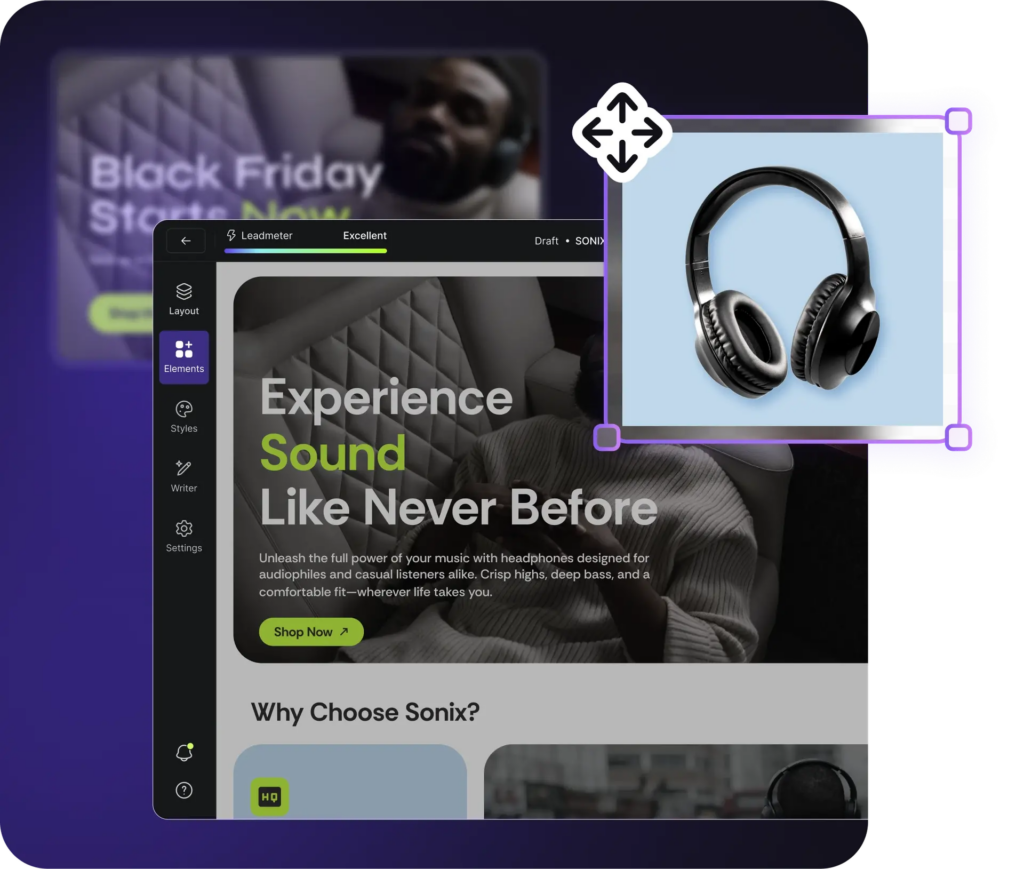
You know, when I first fired up Leadpages back in 2018, I was skeptical about how “easy” it really was. I’ve burned hours on clunky tools before. However, let me tell you about a time last year when I needed a quick landing page for a client’s webinar signup.
I logged in, selected a template from their library (I chose one optimized for events because it had a clean, urgent vibe), and voilà, in under 30 minutes, I had the whole thing customized.
Started by dragging in a headline block, I tweaked the text to match the client’s brand voice and inserted an image from my desktop; no resizing headaches since it auto-adjusts.
Then I added a signup form, connected it directly to my email list tool, and included a countdown timer to increase the FOMO. The real-time preview allowed me to toggle between desktop and mobile views, and yes, it looked sharp on my phone without any extra fiddling.
What I love most is how it autosaves every few seconds; I’ve lost work in other setups, but here it’s like having a safety net.
That page ended up pulling in a 25% conversion rate on the first run, which blew my mind for something so quick.
However, here’s what I don’t love: sometimes the builder feels a bit sluggish if I have a large number of elements loaded, as if it lags when I’m rearranging sections. It’s not a deal-breaker, but it reminds me to keep things simple unless I want to pull my hair out.
Why Leadpages Stands Out in 2025?
Despite competitors like Unbounce, Instapage, and ClickFunnels, Leadpages remains my top pick for solopreneurs and small businesses. Here’s why it beats rivals:
| Platform | Starting Price | Key Features | Why I Chose Leadpages |
| Unbounce | $99/month | Advanced customization, A/B testing. | Too expensive, steeper learning curve. |
| Instapage | $199/month | Pixel-perfect designs, enterprise tools. | Overkill for small businesses, costly. |
| ClickFunnels | $147/month | Full sales funnels, email marketing. | Pricey, less focused on landing pages. |
| Landingi | $29/month | Pixel-perfect editor, 400+ templates. | Less conversion-focused, fewer integrations. |
Why Leadpages Wins?
- Affordability: At $37/month, it’s half the price of Unbounce or ClickFunnels, saving me over $ 700 per year.
- Conversion Focus: Templates and Leadmeter deliver 20-40% conversion rates, beating my old WordPress pages (10-15%).
- Ease of Use: Beginners can build pages in 30 minutes, unlike Unbounce’s complex editor.
- Example: A client’s Leadpages page outperformed a ClickFunnels page by 10% in conversions at half the cost.
Tips for Using Leadpages
Based on my seven years, here’s how to maximize Leadpages:
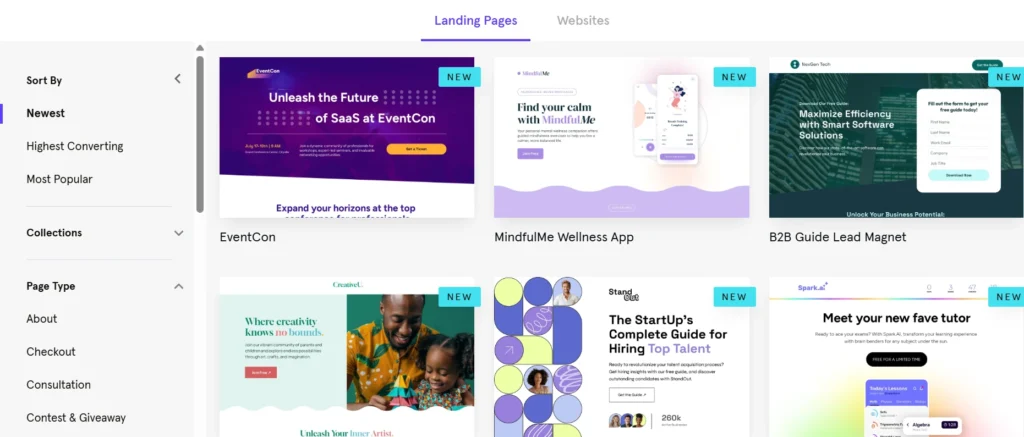
- Start with Templates: Choose high-conversion templates to save time and boost results.
- Use Leadmeter: Follow its real-time tips to improve conversions by 10-20%.
- Set Up Integrations: Link Mailchimp or Stripe early to automate workflows.
- Test with Pro Plan: Use A/B testing to find winning designs, worth the $74/month.
- Try the Free Trial: Test all features for 14 days, set a reminder to avoid auto-charges.
- Join the Community: Leadpages’ X community and weekly coaching calls offer free tips.
AI Features and Future-Proofing
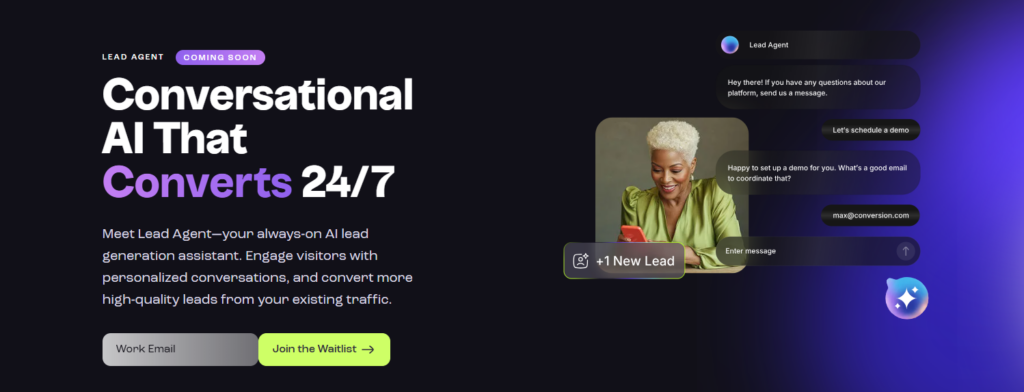
Lately, I’ve been geeking out over the AI stuff in Leadpages; it’s like having a copywriter in my pocket.
The writing assistant cranks out headlines, body text, or even full sections based on a prompt, and with the credits on my Pro plan, I’ve used it to A/B test variations without staring at a blank page for hours.
For a recent ebook promo, I fed it my key points, and it generated engaging copy that I tweaked in minutes; conversions jumped because it nailed the persuasive tone I sometimes struggle with.
I love how it keeps the tool feeling fresh in 2025, especially with all the AI hype out there; it helps me stay competitive without requiring me to learn a whole new skill.
However, here’s my gripe: the credit system depletes quickly if you’re heavy on generation, and buying more feels like an additional tax.
Plus, the AI isn’t perfect; sometimes it spits out generic fluff that needs heavy editing, reminding me it’s a helper, not a replacement for my own brain.
FAQs related to Leadpages Review
What is Leadpages?
Leadpages is a powerful landing page builder that helps businesses create high-converting pages for lead generation, sales, and marketing campaigns.
Is Leadpages beginner-friendly?
Yes, Leadpages is designed with an easy-to-use drag-and-drop editor, making it simple for beginners to design and launch landing pages without needing to code.
Does Leadpages offer a free trial?
Yes, Leadpages offers a 14-day free trial to help you explore its features and see if it’s the right tool for your business needs.
Are the landing pages mobile-friendly?
Yes, all landing pages created with Leadpages are automatically optimized for mobile devices to ensure a seamless user experience.
Does Leadpages provide A/B testing?
Yes, Leadpages includes built-in A/B testing features to help you test and optimize landing pages for better performance.
Quick Links
Final Conclusion- Leadpages Review in 2025?
After seven years and 30+ landing pages, I can say Leadpages is absolutely worth it in 2025! The Leadpages Review 2025 shows it’s an affordable, powerful, and easy-to-use builder for solopreneurs and small businesses.
At $37/month, the Standard plan delivers high-converting templates, unlimited leads, and 40+ integrations, saving $50-$100/month compared to Unbounce or ClickFunnels. The Pro plan ($74/month) adds A/B testing and payments, driving my clients’ revenue by $5,000+/month.
Yes, customization is limited, and A/B testing requires Pro, but the 20-40% conversion rates and fast setup make up for it. Try Leadpages’ 14-day free trial at leadpages.com to see why it’s still my go-to for lead generation in 2025!
